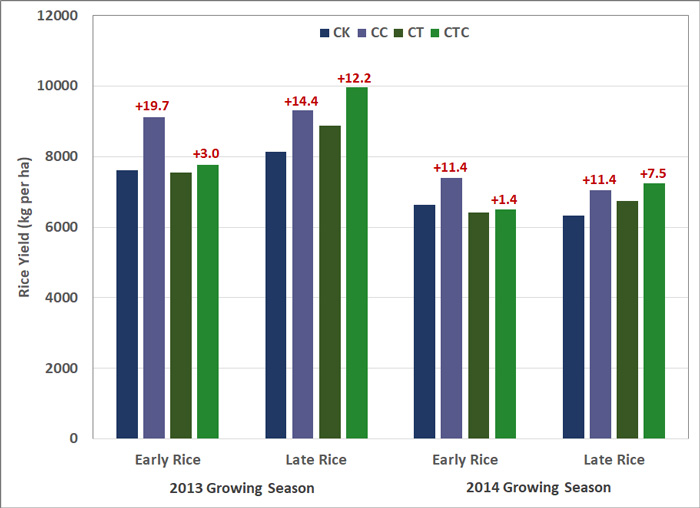| Tweet | Follow @co2science |
Paper Reviewed
Wang, B., Li, J., Wan, Y., Li, Y., Qin, X., Gao, Q., Waqas, M.A., Wilkes, A., Cai, W., You, S. and Zhou, S. 2018. Responses of yield, CH4 and N2O emissions to elevated atmospheric temperature and CO2 concentration in a double rice cropping system. European Journal of Agronomy 96: 60-69.
Much remains to be learned about the relationship between temperature, atmospheric CO2 and crop yields, which topic was the focus of a recent paper by Wang et al. (2018).
Writing in the European Journal of Agronomy, the eleven scientists conducted an open-top chamber study where they grew rice (Oryza sativa) at the Jingzhou Agro-meteorological Experimental Station in Hubei Province, China, under two different temperatures (ambient or ambient +2 °C) and two atmospheric CO2 concentrations (ambient or ~60 ppm above ambient) over a period of two years. In each year, two separate cultivars were grown and harvested under these conditions, an early (cv Liangyou 287) and late (cv Xiangfengyou 9) season cultivar, which resulted in yield data from four separate harvests in the two-year experimental period.
The results of the study are presented in the figure below, where it can be seen that, compared to ambient conditions, elevated CO2 alone boosted rice yields by 19.7% in 2013 and 11.4% in 2014 for the early rice variety and by 14.4% and 11.4% for the late season variety. Elevated temperature alone had no impact on early rice in 2013 and only a slightly negative impact on yields in 2014. In contrast, higher temperatures increased yields of the late season cultivar in both years by 6-9%.
In the combination elevated CO2 and elevated temperature treatment, yields of both rice cultivars were consistently higher than those observed in the elevated temperature treatment alone, whereas compared with the elevated CO2 alone treatment, yields were smaller for early rice, but larger for late season rice.
Given the above findings, it is likely that future rice yields in both the early and late season will be enhanced. This outcome becomes even more probable when one recognizes that the +60 ppm increase of atmospheric carbon dioxide utilized in the authors' experimental design is far below the likely 300 ppm increase that is projected to occur by the end of this century. The additional 240 ppm increase in atmospheric CO2 will only further serve to increase the yields above the enhancements observed here. Nevertheless, it is also important to note that this small 60 ppm increase in CO2 was sufficient to totally ameliorate the negative impacts of elevated temperature on the yields of early rice and was an additive enhancement on yields for late season rice.

Figure 1. Yield responses of early and late season rice to changes in atmospheric CO2 and temperature conditions. Legend: CK = ambient temperature and ambient CO2, CC = ambient temperature and elevated CO2, CT = elevated temperature and ambient CO2, and CTC = elevated temperature and elevated CO2. The percent change in yield between growing condition pairs CC and CK, and CTC and CT, are shown in red text above the CC and CTC columns for each rice growing season. Graphic created using data presented in Table 3 of Wang et al. (2018).




